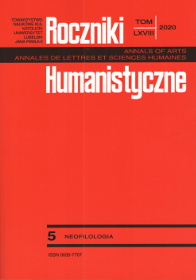„Orte, die die Erinnerung verloren haben“: Die Landschaften des Postgedächtnisses in die Pfefferfälscher. Geschichte einer Familie von Monika Sznajderman
Abstrakt
„Miejsca, które straciły pamięć”: Krajobrazy postpamięci w Fałszerzach pieprzu. Historii rodzinnej Moniki Sznajderman
Monika Sznajderman rekonstruuje w swojej prozie wspomnieniowej losy żydowskiej rodziny ze strony ojca, mierząc się z perspektywy postpamięci z traumatycznym doświadczaniem przeszłości – życia przed wojną i zagłady wojennej – przez kolejne pokolenia. Artykuł analizuje sposób postrzegania i literackiego przedstawiania krajobrazu po Zagładzie, podkreślając transgeneracyjny przekaz doświadczeń i podwójne postrzeganie miejsc. Krajobrazy postpamięci są dla spadkobierców traumy skażone przez dominujące odczucie pustki, nieobecności ich byłych mieszkańców i wspomnienia (bądź milczenie) ocalonych. Odwiedzone przez autorkę konkretne miejsca jej historii rodzinnej są zawieszone pomiędzy przeszłością a teraźniejszością. Równoczesna obecność i brak śladów niegdysiejszego żydowskiego życia naznacza je aurą niesamowitości. W artykule podkreślona zostaje również rola ocalonych z Zagłady rodzinnych fotografii, poświadczających istnienie i normalne życie żydowskich przodków i pokazujących „miejsca, które straciły pamięć”.
„Orte, die die Erinnerung verloren haben“: Die Landschaften des Postgedächtnisses in die Pfefferfälscher. Geschichte einer Familie von Monika Sznajderman
Monika Sznajderman rekonstruiert in ihrer Erinnerungsprosa das Schicksal der jüdischen Familie väterlicherseits, indem sie sich aus der Perspektive des Postgedächtnisses mit der traumatischen Erfahrung der Vergangenheit – des Vorkriegslebens und der Vernichtung – auseinandersetzt. Im Artikel werden die Betrachtungsweise und die literarische Darstellung der Landschaft nach der Shoah untersucht, wobei die transgenerationelle Überlieferung und die Doppelwahrnehmung der Orte betont werden. Die Landschaften des Postgedächtnisses sind für die Erben des Traumas durch das vorherrschende Gefühl der Leere, der Abwesenheit ihrer ehemaligen Bewohner und die Erinnerungen (oder das Schweigen) der Überlebenden kontaminiert. Die von der Autorin besuchten konkreten Orte ihrer Familiengeschichte befinden sich in der Schwebe zwischen Vergangenheit und Gegenwart. Das gleichzeitige Vorhandensein und Fehlen der Spuren des einstigen jüdischen Lebens verleiht ihnen eine unheimliche Aura. Im Artikel wird ebenfalls die Rolle der geretteten Familienfotos hervorgehoben, die die Existenz und das normale Leben der jüdischen Ahnen bestätigen und “Orte, die die Erinnerung verloren haben“ zeigen.
Bibliografia
Aichinger, Ilse. Subtexte. Journal. Edition Korrespondenzen, 2006.
Assmann, Aleida. Erinnerungsräume. Formen und Wandlungen des kulturellen Gedächtnisses. 3. Ausgabe. C.H. Beck, 2006.
Barthes, Roland. Die helle Kammer. Bemerkung zur Photographie. Translated by Dietrich Leube, Suhrkamp, 1989.
Bojarska, Katarzyna. “Historia Zagłady i literatura (nie)piękna. Tworki Marka Bieńczyka w kontekście literatury posttraumatycznej.” Pamiętnik Literacki, vol. 99, fasc. 2, 2008, pp. 89-106.
Fuchs, Anne. “Von Orten und Nicht˗Orten. Fremderfahrung und dunkler Tourismus in Sebalds Prosa.” W. G. Sebald. Intertextualität und Topographie, edited by Irene Heidelberger˗Leonhard und Mireille Tabah, LIT, 2009, pp. 55-71.
Hirsch, Marianne. Family Frames. Photography, Narrative and Postmemory. Harvard UP, 1997.
Hirsch, Marianne. “Surviving Images: Holocaust Photographs and the Work of Postmemory.” The Yale Journal of Criticism, vol. 14, no. 1, 2001, pp. 5-37.
Meyran, Régis. “Génocides. Lieux (et non-lieux) de mémoire.” Revue d’histoire de la Shoah, le Monde juif, vol. 181, 2004, pp. 138-139.
Moré, Angela. “Die unbewusste Weitergabe von Traumata und Schuldverstrickungen an nachfolgende Generationen.” Journal für Psychologie, vol. 21, 2, 2013, pp. 1-34.
Pastuszka, Anna. “‘Kontaminierte’ ostmitteleuropäische Landschaften bei Hanna Krall und Andrzej Stasiuk”. Auf den Ruinen der Imperien. Erzählte Grenzräume in der mittel- und osteuropäischen Literatur nach 1989, edited by Andree Michaelis-König, Neofelis Verlag, 2018, pp. 87-108.
Szczepan, Aleksandra. “Krajobrazy postpamięci.” Teksty Drugie, no. 1 (145), 2014, pp. 103˗126.
Copyright (c) 2020 Roczniki Humanistyczne

Utwór dostępny jest na licencji Creative Commons Uznanie autorstwa – Użycie niekomercyjne – Bez utworów zależnych 4.0 Międzynarodowe.





